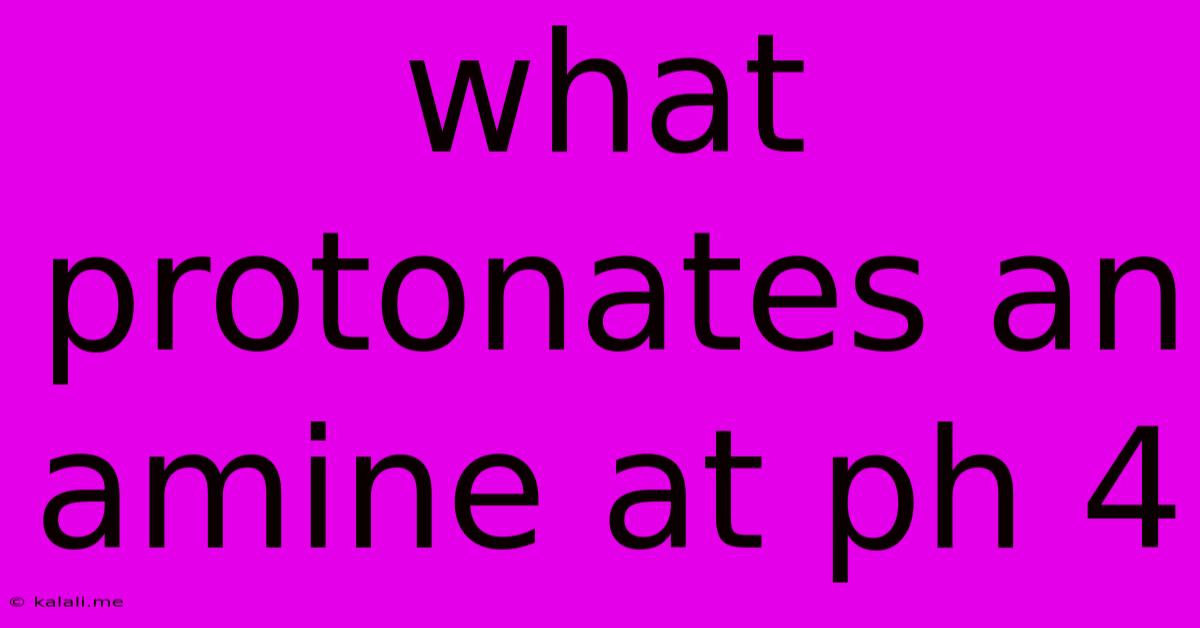What Protonates An Amine At Ph 4
Kalali
Jun 10, 2025 · 3 min read

Table of Contents
What Protonates an Amine at pH 4? Understanding Acid-Base Chemistry
Meta Description: This article explains the protonation of amines at pH 4, detailing the role of hydronium ions, pKa values, and the influence of amine structure on protonation behavior. Learn about the factors determining whether an amine will be protonated under acidic conditions.
At pH 4, the environment is decidedly acidic. Understanding what causes an amine to protonate under these conditions requires a grasp of fundamental acid-base chemistry. This article will explore the process, focusing on the key players and factors influencing the protonation of amines.
The Role of Hydronium Ions (H₃O⁺)
The key to understanding amine protonation at pH 4 lies in the abundance of hydronium ions (H₃O⁺). At pH 4, the concentration of H₃O⁺ is significantly higher than at neutral pH (pH 7). These hydronium ions act as the protonating agents. They readily donate a proton (H⁺) to the amine's nitrogen atom.
Amine pKa and Protonation
The crucial factor determining whether an amine will be protonated at a given pH is its pKa value. The pKa represents the acidity of the conjugate acid of the amine. A lower pKa indicates a stronger acid, meaning its conjugate base (the amine) is weaker and less likely to accept a proton. Conversely, a higher pKa indicates a weaker acid and a stronger base, making it more likely to accept a proton.
Most aliphatic amines have pKa values in the range of 9-11. Aromatic amines generally have lower pKa values, typically between 4 and 5. This difference arises from the delocalization of the positive charge on the nitrogen atom in the aromatic ring system.
At pH 4, the concentration of H₃O⁺ is significantly greater than the concentration of the amine's conjugate base (which determines protonation). Therefore, amines with pKa values above 4 are likely to be largely protonated at pH 4. This is because the equilibrium favors the protonated form (ammonium ion).
The Protonation Reaction
The reaction of an amine with a hydronium ion can be represented as follows:
R₃N + H₃O⁺ ⇌ R₃NH⁺ + H₂O
Where R represents alkyl or aryl groups attached to the nitrogen atom. The equilibrium lies to the right at pH 4 for amines with pKa > 4, indicating a preference for the protonated form (R₃NH⁺).
Factors Influencing Amine Protonation
Several factors can influence the extent of amine protonation at pH 4, beyond the amine's inherent pKa:
- Steric hindrance: Bulky groups around the nitrogen atom can hinder the approach of the hydronium ion, reducing the rate of protonation.
- Resonance effects: As mentioned, resonance effects in aromatic amines significantly lower the pKa, making them less basic and less likely to be protonated at pH 4 compared to aliphatic amines.
- Solvent effects: The solvent used can also influence the equilibrium, impacting the extent of protonation.
Conclusion
In summary, at pH 4, the high concentration of hydronium ions (H₃O⁺) readily protonates amines. The likelihood of protonation hinges primarily on the amine's pKa value. Amines with pKa values greater than 4 will be substantially protonated at pH 4, while those with pKa values significantly below 4 will remain largely unprotonated. Steric effects, resonance effects, and solvent effects also play supporting roles in determining the extent of protonation. Understanding these factors is crucial for predicting and controlling the behavior of amines in acidic environments.
Latest Posts
Latest Posts
-
How To Keep A Dog Out Of My Yard
Jun 11, 2025
-
How To Check If Head Gasket Is Blown
Jun 11, 2025
-
How To Respond To A Job Offer Email
Jun 11, 2025
-
What Variable Goes On The Y Axis
Jun 11, 2025
-
How Long Was Boba Fett In The Sarlacc Pit
Jun 11, 2025
Related Post
Thank you for visiting our website which covers about What Protonates An Amine At Ph 4 . We hope the information provided has been useful to you. Feel free to contact us if you have any questions or need further assistance. See you next time and don't miss to bookmark.